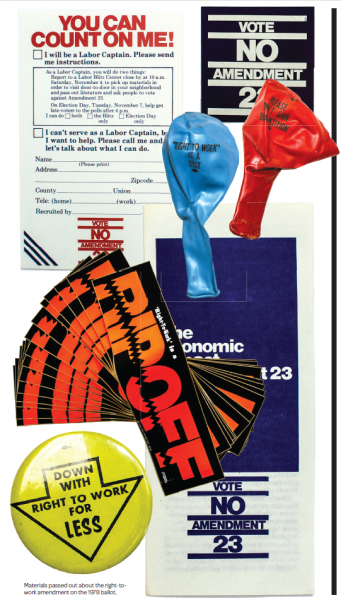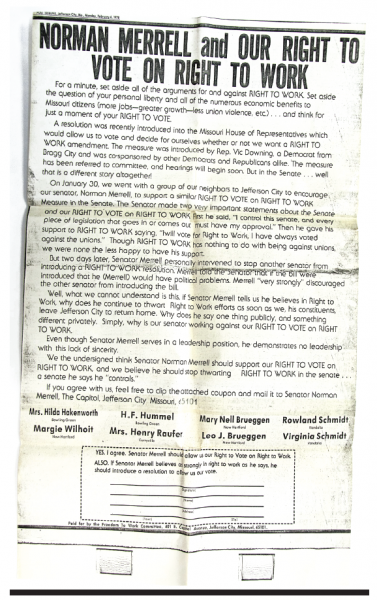Labor and Politics
 As the right-to-work battle sluggishly carries on, the Business Times evaluates these labor laws and what they could mean if adopted in Missouri.
As the right-to-work battle sluggishly carries on, the Business Times evaluates these labor laws and what they could mean if adopted in Missouri.
Right to work.Those three words have sparked a bitter controversy in Missouri and across the nation. For the past two years, the legislation has grown in popularity in Missouri, with its reputation for economic growth. Although it’s one of hundreds of sections in the Taft-Hartley Act, it’s the only section that has become a household phrase—even if what it is, and what it means for Missouri, remains elusive.
“It’s really just one small part of a big labor law,” said Herb Johnson, secretary-treasurer of the American Federation of Labor and Congress of Industrial Organizations (AFL-CIO) of Missouri. “One of the biggest problems is that people don’t really understand Right To Work.”
Current federal law mandates that a union must represent all employees, including non-union members. In non-Right To Work states like Missouri, when a company’s employees create a union, it must negotiate a contract with the employer. One decision both union and employer must make is whether or not non-union members have to pay fees for the benefits they receive through union representation.
Paul Rainsberger, the director of the Labor Education program at MU, said the fees, by law, cover the expenses of collective bargaining, legal representation and other union efforts. An employer can choose not to do so, but the newfound collective power of the union could choose not to ratify the contract, or eventually strike, according to Sam White.
Right To Work outlaws payment of these fees as a condition of employment, regardless of union pressure. If Missouri passed the legislation, Johnson fears fewer employees would join the union, since they will benefit regardless. Strong consensus among academic researchers concludes that although Right To Work has a minimal effect on union density, it tends to inhibit union growth.
Affecting local profit
Mike LaGesse is a welder in the local Millwrights union. He said the companies he works for benefit from hiring union workers. “You know you’re working with skilled people who know how to do their job and do it well,” he said. “With Right To Work, less experienced and less skilled workers will take our work away.” Ultimately he said he thinks it will decrease his wages, which are $30 per hour, locally.
In 2011, union workers made on average $10,800 more than non-union workers, according to the Bureau of Labor Statistics (BLS). For a hypothetical union company with 100 employees, that totals more than $1 million each year that could go towards reinvestment, expansion, or greater profits for investors and owners. A study published in the Southern Economic Journal in 2000 found that proprietors and investors see noticeably greater profit margins in Right To Work states. Two local mid-size companies, one in the transport industry and the other, electric, said this additional profit margin is the only thing keeping them in business—if they had to pay union wages, they would have to close their doors.
In February 2011, the Missouri Chamber of Commerce announced its support for the legislation in Missouri, following a survey of its members, which found that 87 percent were in favor. Additionally, it found that more than one-third of its member-companies said they are negatively affected by Missouri’s status as a non-Right To Work state. Although the survey was anonymous, the members cited the following comments, among others:
- A healthy business environment is necessary to get this state’s economy going again… Missouri needs to do all it can to position itself to be “business friendly”.
- Any legislation encouraging businesses to locate in Missouri will enhance our ability to do business with them—Right To Work would do that.
- Although not being a Right To Work state hasn’t specifically hindered our company, I understand that many economic development opportunities have been lost.
Balance of power
A sign of the continuing power imbalance is the difficulty of getting businesses to talk about unions. Multiple union shops feared retribution. Non-union shops, too, would not speak on record for fear of drawing attention from external unions who might lobby its workers to unionize.
“[The proponents of] this legislation say we would be doing so much better economically, that we’d have money falling from heaven,” Johnson said. And although there is merit behind fears that passing Right To Work decreases wages—by an average of $1,500 per year, per person, according to the BLS—the legislation also has merit as an economic development tool.
A study by economist Thomas Holmes, published in the Journal of Political Economics, found that although manufacturing activity in non-Right To Work states was stagnant, states that passed the legislation experienced an average increase of 150 percent.
“A lot of people who are expanding and starting companies don’t want to deal with [union shops], and with the advancement in productivity and technology, there’s less of an emphasis on joining a union,” said Daniel Mehan, president and CEO of the Missouri Chamber of Commerce. He said the president of the Indiana Chamber of Commerce reported a 38 percent increase in new plant and plant expansion inquiries following the passing of the legislation in Indiana.
Both of those numbers are significant, but it’s impossible to determine how much Right To Work alone affects a state’s success. These states often use the legislation as just one tool in a box full of benefits for businesses.

The push for job creation
Following Holmes’ study on manufacturing activities, he conducted a second study on metropolitan areas that span the border between a Right To Work and a non-Right To Work state—like Kansas City. Holmes found that although Right To Work is a factor, the more important economic development factors included low taxes and levels of regulation, a good infrastructure and education system, as well as inexpensive electricity and land.
In the case of the Missouri-Kansas border, it was the total economic incentive package, including Right To Work, that prompted businesses to cross the state line into Kansas.
According to a spokesperson for the Kansas Chamber of Commerce, in the fiscal year of 2009, 45 of the 53 companies that received tax incentives to move to Kansas came from Missouri. Only one moved from Kansas to Missouri, according to Missouri figures.
In late September, for example, truck dealer Murphy-Hoffman announced plans to move its headquarters and 100 jobs from Kansas City, Mo., to Leawood, Kansas. Just one week prior, Hantover, Inc., a distributor of general manufacturing and food processing industries, moved 91 jobs from Kansas City, Mo., to Overland Park, Kansas.
“Especially in the economic downturn, we’re looking for anything to get a leg up on job creation,” said Mehan. An arsenal of economic incentive packages, including Right To Work, is one available tool. But the legislation isn’t on the ballot this year, and if past patterns of a Right To Work push are any indication, it may not be an issue next year.
“Once the economy recovers, there won’t be such a push for it,” said White, the MU historian.
He says interest in the legislation usually surfaces in patterns, often during or following a recession or the defeat of labor law reform. Right To Work legislation has only made it to the ballot once in Missouri, in 1978 as Amendment 23.
“When labor law reform is a dismal failure, those in favor of Right To Work in state legislatures become more bold,” White said.
Missouri’s workforce
Following the failure of the Carter labor reforms of 1977, the National Right To Work Committee targeted Missouri as a candidate for the legislation. Missouri had just experienced a conservative shift—from voting for the Republican presidential candidate one quarter of the time before the ‘70s to three quarters of the time since.
President Obama’s Employee Free Choice Act, which aimed to amend the National Labor Relations Act on 1935, failed in 2009. Along with the current recession, Right To Work once again gained strength. Although many of the current Right To Work states are in the South, which was almost blanketed as a Right To Work region following Taft-Hartley, the 2011 addition of Indiana—long a Rust Belt, high union density state—was a blow to organized labor.
“It’s the chicken and the egg argument. Was Right To Work allowed because labor in the South was weak, or was labor in the South weak because of Right To Work?” Rainsberger asks. “I think it’s because labor was weak.”
Missouri, with St. Louis as one the U.S.’s great union cities and strong organization in Kansas City, has long been a stalwart for organized labor. When the issue emerged on the ’78 ballot, the unions fought hard against it. Although Boone County voted in favor of the legislation, Amendment 23 failed three to two statewide.
In 1978, about 20 percent of Missouri’s workforce was union. That number now hovers around 10 percent. Since much of the manufacturing industry, one of the most unionized sectors of the American workforce, has greatly declined in the U.S., union numbers have followed suit. According to a study by the Missouri Economic Research & Information Center, Missouri’s fastest-growing sectors are service and retail. These are also two sectors that happen to have very low union participation. White said when union density falls below a certain level, Right To Work legislation is more likely to pass.
Although the patterns indicate that this is Missouri’s best chance in history to pass the legislation, it isn’t going to happen this November.



